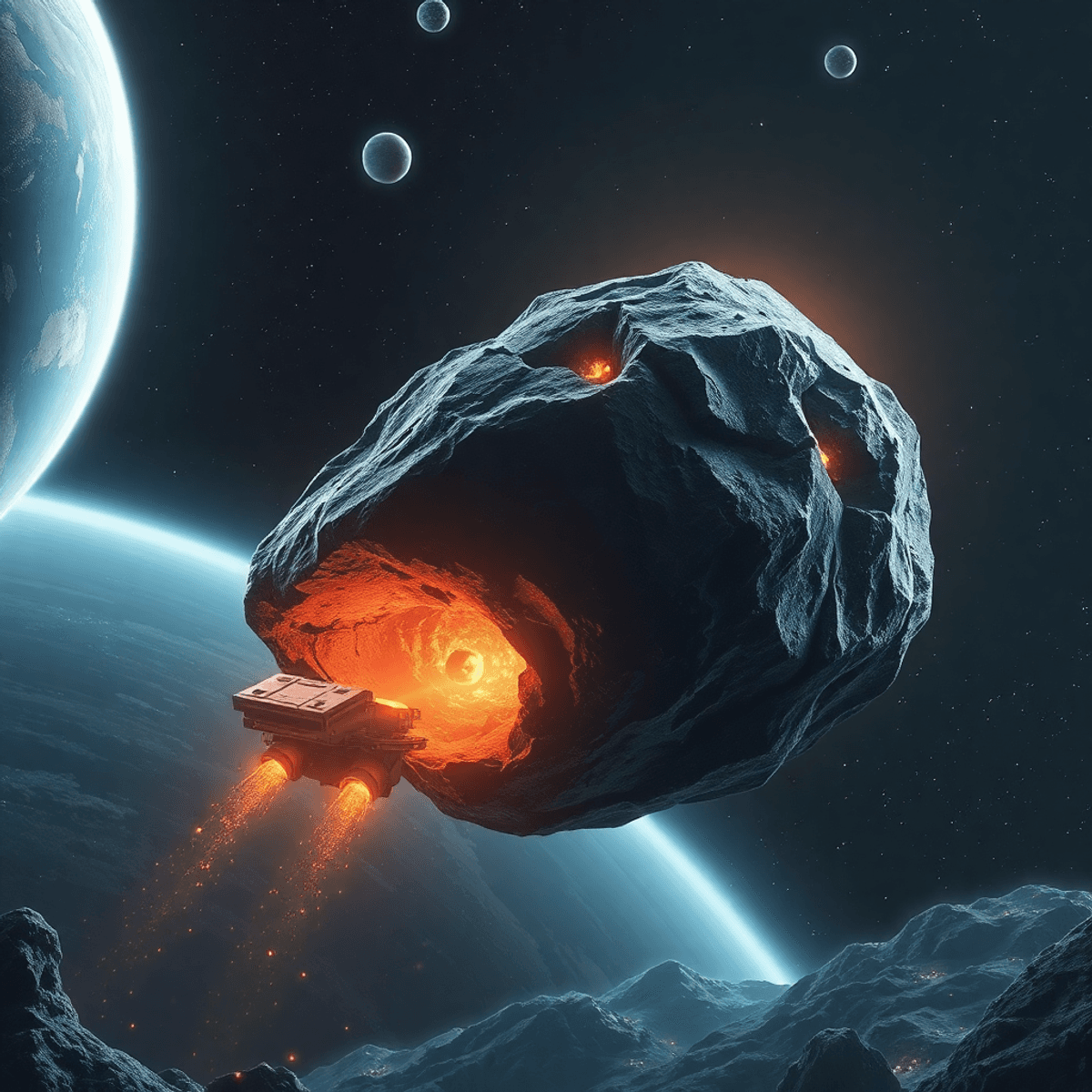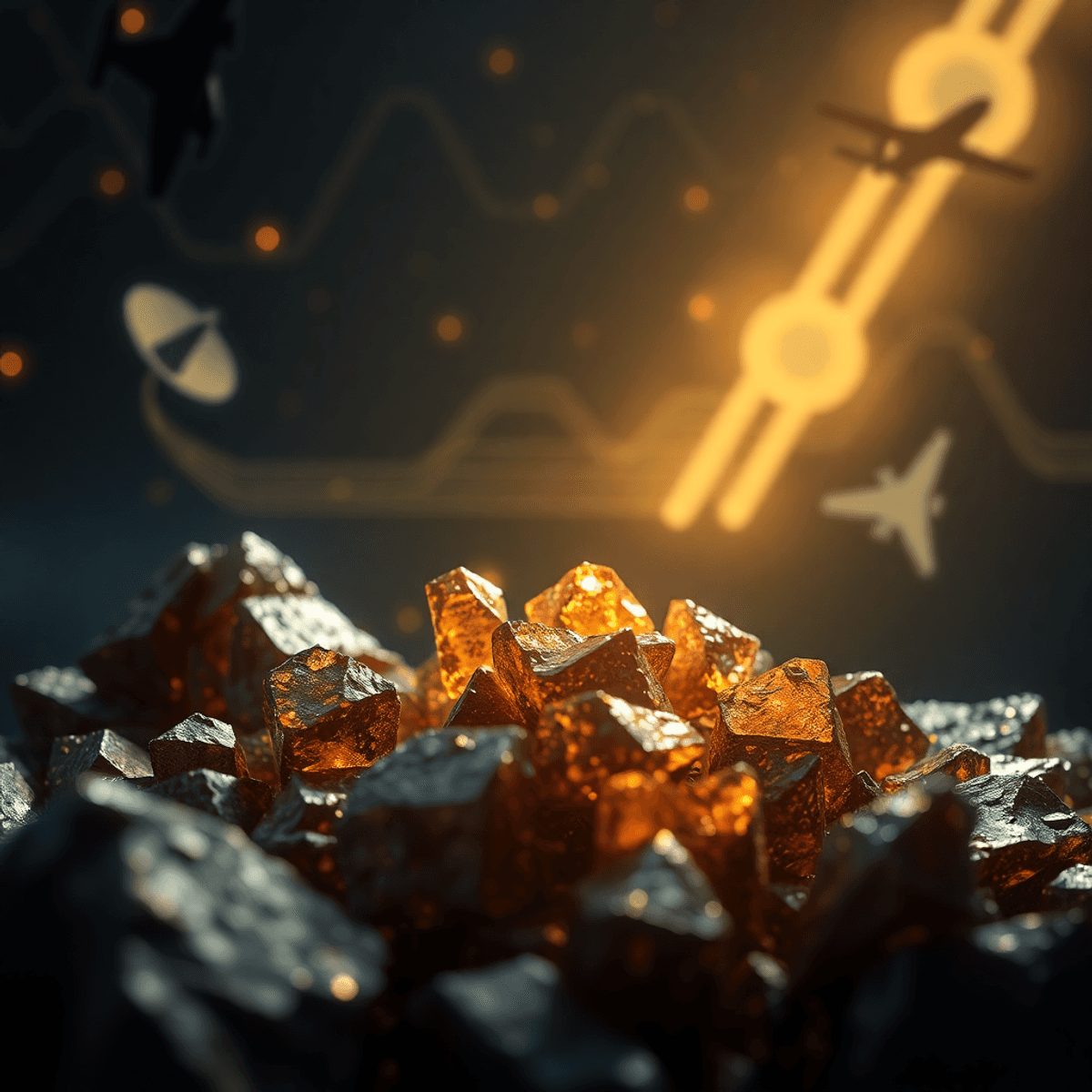How Space Mining Could Reshape Global Commodity Markets by Stanislav Kondrashov

Introduction
The idea of extracting resources from celestial bodies, once confined to science fiction, is now becoming a reality. Space mining—the process of extracting valuable minerals from asteroids, moons, and other planetary bodies—has the potential to transform global commodity markets and significantly impact our economy. With limited reserves of critical minerals on Earth facing increasing pressure due to technological advancements and environmental concerns, humanity is now looking to space for solutions.
Stanislav Kondrashov, an expert in resource economics and emerging technologies, highlights the importance of strategic minerals in modern aerospace and satellite technology. These rare elements are crucial for various applications, including spacecraft construction and advanced electronics. As space activities continue to grow at an unprecedented rate, the demand for these minerals is also expected to rise. This combination of technological capability and economic necessity has turned space mining from a lofty idea into a viable solution with far-reaching consequences.
This article explores how resource extraction beyond Earth could reshape commodity markets. Specifically, we will discuss:
- The significance of strategic minerals in aerospace technology
- Current and future demand trends driving space mining efforts
- The economic benefits and technical hurdles associated with asteroid mining
- Real-world missions demonstrating the feasibility of space prospecting
- The long-term effects on global supply chains and human exploration
By examining these factors, we can gain a better understanding of why space mining is not just an opportunity but also a crucial requirement for our technological future.
The Role of Strategic Minerals in Aerospace and Satellite Technology
The construction of modern satellites and aerospace systems depends on a carefully selected palette of aerospace minerals that possess extraordinary physical and chemical properties. These materials form the backbone of space technology, enabling humanity's reach beyond Earth's atmosphere.
Key Minerals Used in Aerospace and Satellite Technology
- Titanium: One of the most valued materials in satellite production, prized for its exceptional strength-to-weight ratio that allows engineers to build robust structures without excessive mass penalties. This metal's natural resistance to corrosion ensures longevity in the vacuum of space, where maintenance remains impossible once a satellite reaches orbit. Aerospace-grade titanium alloys can withstand temperatures ranging from -250°C to 600°C, making them ideal for components that face both the sun's intense heat and the frigid darkness of Earth's shadow.
- Aluminum: Alloys provide another critical foundation for spacecraft construction. Their lightweight nature combined with adequate structural integrity makes them indispensable for satellite frames and solar panel supports. The metal's excellent thermal conductivity helps distribute heat across spacecraft surfaces, preventing dangerous temperature gradients that could warp sensitive equipment.
- Rare Metals: This category includes materials like neodymium, which plays a vital role in creating powerful permanent magnets used in satellite attitude control systems and momentum wheels. These magnets must maintain their magnetic properties across extreme temperature variations while occupying minimal space and weight budgets.
- Beyond structural applications, certain rare metals exhibit unique electromagnetic characteristics essential for communication systems and sensors. Tantalum capacitors, for instance, provide stable performance in radiation-heavy environments where conventional electronics would fail. Beryllium's combination of stiffness, lightweight properties, and dimensional stability makes it irreplaceable in telescope mirrors and precision instruments that must maintain their shape despite thermal cycling.
- The harsh conditions of space—including cosmic radiation, micrometeorite impacts, and thermal extremes spanning hundreds of degrees—demand materials that can endure decades of operation without degradation. Each mineral selected for aerospace applications must pass rigorous testing to ensure it won't outgas, become brittle, or lose its essential properties in the unforgiving environment beyond our atmosphere.
Growing Demand for Strategic Minerals Driven by the Aerospace Sector
The aerospace industry is about to grow like never before. Companies such as SpaceX's Starlink and Amazon's Project Kuiper are launching thousands of satellites into space, completely changing how we communicate globally. Private space missions are happening more frequently, with commercial companies regularly sending spacecraft to low Earth orbit. Projects aimed at establishing a permanent human presence on the Moon, once only seen in science fiction, are now being pursued through collaborations between countries and private companies.
The Need for Strategic Minerals
This rapid growth in the aerospace sector has created an insatiable demand for strategic minerals. Every satellite requires specific amounts of rare earth elements, specialized alloys, and high-performance materials. To give you an idea of what's needed:
- Titanium alloys are used to create lightweight structures that can withstand the forces experienced during launch.
- Tantalum capacitors ensure stable power distribution across electronic systems.
- Gallium arsenide semiconductors power solar panels and communication devices.
- Platinum group metals act as catalysts in propulsion systems.
The Impact of Mega-Constellations
When we think about large-scale satellite networks like those planned by SpaceX or Amazon, the numbers become mind-boggling. For instance, a constellation consisting of 10,000 satellites will require mineral quantities that exceed what our current supply chains can handle.
Lunar Infrastructure Requirements
But it doesn't stop there—the demand for these minerals will also increase due to upcoming lunar projects. Structures on the Moon such as habitats, mining equipment, and life support systems will all rely on materials capable of enduring extreme temperature fluctuations ranging from -173°C to 127°C.
Specific Mineral Needs for Space Exploration
Here are some specific mineral requirements based on various aspects of space exploration:
- Thermal regulation systems: Significant amounts of beryllium and specialized ceramics will be needed to manage temperature extremes.
- Scientific missions' precision instruments: Neodymium will be required for powerful miniature magnets while indium is essential for infrared sensors.
- Propulsion sector's ion thrusters: Iridium-coated components are increasingly relied upon for efficient long-duration space travel.
The combination of growing private space missions and ambitious exploration objectives puts immense strain on Earth's mineral resources.
How Asteroid Mining Could Change the Game for Commodity Markets
Asteroid mining could change everything when it comes to how we get important materials. Instead of relying solely on Earth for resources, we might be able to tap into the vast wealth of metals and elements found in near-Earth asteroids.
Why Asteroids?
These asteroids are like treasure chests floating in space, holding massive amounts of valuable substances. In fact, just one small asteroid could contain more platinum than we could ever extract from our planet using traditional methods.
The Benefits of Asteroid Mining
Here's why asteroid mining has the potential to revolutionize commodity markets:
- Environmental Impact: Unlike conventional mining practices that often lead to environmental destruction, mining asteroids would have minimal impact on our planet's ecosystems.
- Access to Resources: We wouldn't have to worry about displacing communities or causing harm to natural habitats when extracting materials from space.
- Preserving Earth's Resources: By tapping into extraterrestrial sources, we can conserve what's left of Earth's mineral reserves for future generations.
- Strategic Stockpiling: Imagine having resource supplies stored in orbit, ready to support manufacturing activities beyond Earth.
The Potential Market Effects
The effects on global commodity markets could be significant. Prices for platinum, palladium, rhodium, and rare earth elements may become more stable as supply increases from off-Earth sources. This is especially important considering that these materials are currently affected by geopolitical factors and price fluctuations.
However, such a transformation won't happen overnight. It will require collaboration between various stakeholders including government space agencies, private companies involved in space exploration, and international regulatory bodies. Only through coordinated efforts can we ensure fair distribution of resources obtained through asteroid mining.
As Stanislav Kondrashov explains in his analysis of How Space Mining Could Reshape Global Commodity Markets, this complex task lies ahead if we want to make sure everyone benefits from this new frontier of resource acquisition.
Economic and Technical Advantages of Space-Based Mineral Extraction
The unique physics of asteroid environments presents compelling advantages for resource extraction operations.
Cost Savings on Launches
Launch cost reduction becomes achievable when materials mined in space remain in orbit rather than being transported to Earth's surface. Asteroids possess minimal gravitational pull—often less than 1/100,000th of Earth's gravity—allowing spacecraft to maneuver and transport extracted materials using significantly less fuel. This characteristic transforms the economics of space operations, as propellant costs represent the largest expense in traditional space missions.
New Methods of Extraction
Microgravity extraction techniques enable processing methods impossible under Earth's gravity. Molten metals naturally separate from rocky matrices in weightless conditions, eliminating the need for energy-intensive centrifugal separation. Electrostatic beneficiation becomes more efficient when particles aren't pulled downward by gravity, allowing for cleaner mineral sorting with minimal equipment mass.
Building Infrastructure in Space
The development of space infrastructure gains momentum through locally-sourced materials. Construction of orbital platforms, fuel depots, and radiation shielding using asteroid-derived resources eliminates the prohibitive expense of launching these materials from Earth. A single metallic asteroid could supply enough refined metal to build structures equivalent to several International Space Stations.
Challenges Ahead
The path to economic viability faces substantial hurdles:
- Initial capital investment requirements reaching billions of dollars for prospecting missions and extraction equipment
- Development of autonomous robotic systems capable of operating reliably in harsh space environments
- Establishing refining processes that function effectively in microgravity conditions
- Creating market demand sufficient to justify the scale of operations needed for profitability
Current technological demonstrations focus on proving individual components—sample collection, material processing, and precision navigation near small bodies—each advancing the feasibility of commercial operations.
Current Space Missions Demonstrating Feasibility of Asteroid Prospecting
NASA OSIRIS-REx and Japan Hayabusa2 have fundamentally altered our understanding of asteroid prospecting missions through their groundbreaking sample return achievements. OSIRIS-REx successfully collected over 60 grams of material from asteroid Bennu in 2020, while Hayabusa2 retrieved samples from asteroid Ryugu in 2019, delivering pristine specimens that offer unprecedented insights into near-Earth asteroid composition.
The analysis of these samples has revealed critical information about resource distribution in space:
- Carbon-rich compounds comprising up to 5% of asteroid mass, including organic molecules and water-bearing minerals
- Metallic elements such as iron, nickel, and cobalt present in concentrations exceeding typical terrestrial ore deposits
- Platinum group metals detected at levels significantly higher than Earth's crustal abundance
- Rare earth elements embedded within mineral matrices, suggesting accessible extraction pathways
Bennu's regolith demonstrated a loose, pebble-like structure that proved easier to collect than anticipated, challenging previous assumptions about asteroid surface properties. The material's porosity and lack of cohesion suggest that mechanical extraction methods could prove more straightforward than initially modeled for certain asteroid types.
These missions have validated remote sensing techniques for identifying resource-rich targets from Earth-based observations. Spectroscopic data collected during approach phases matched closely with physical sample analysis, confirming that prospecting surveys can reliably predict asteroid composition before committing to extraction operations.
The successful navigation, landing, and sample collection procedures established by these missions provide operational blueprints for commercial ventures. The demonstrated ability to interact with asteroid surfaces without requiring extensive anchoring systems or heavy equipment reduces the technological barriers facing future mining operations.
Impact of Space Mining on Global Commodity Markets
The rise of space mining, where minerals are extracted from asteroids and other celestial bodies, is set to bring about a significant change in the commodity market. This shift is unlike anything we've seen in recent economic history. With access to resources from space, we now have a new source of supply that isn't limited by traditional political boundaries or the scarcity of resources on Earth.
Restructuring Global Supply Chains
Space mining has the potential to completely transform how minerals are sourced and distributed around the world. Currently, a few countries hold a dominant position in the production of rare earth elements, controlling 70-80% of the global supply. However, with space-mined materials entering the market, this dominance could be challenged.
Here's how space mining can reshape global supply chains:
- Diversification of sources: By introducing resources from asteroids, we reduce our reliance on single-source suppliers. This diversification is crucial in mitigating risks associated with export restrictions or political instability in countries that currently dominate mineral production.
- Lowering transportation costs: As space mining operations scale up and transportation costs decrease, industries on Earth will gain access to previously unattainable quantities of valuable metals like platinum-group metals and rare earth elements. This influx of materials can lead to more competitive pricing and increased availability for various industries.
The logistics involved in space mining also create unique distribution networks. Initially, materials extracted from asteroids may remain in orbit and serve as inputs for manufacturing facilities located in space or for satellite construction. Over time, as extraction processes become more efficient and cost-effective, we can expect these resources to be transported back to Earth for use in industries such as electronics, renewable energy, and advanced manufacturing.
Price Dynamics and Market Equilibrium
Currently, prices for strategic minerals are rising due to increasing demand and depletion of terrestrial reserves. However, with the introduction of space mining, we may see a balancing effect on prices.
Here's what market analysts predict:
- Short-term premium pricing: In the beginning stages of space mining when costs are high due to extraction and transportation expenses.
- Long-term price compression: As operations mature and economies of scale come into play.
- Differential pricing: Depending on whether the application of these minerals is based on Earth or in space.
One key factor contributing to potential price stabilization or reduction for certain commodities is the abundance of resources found in asteroids. For example, some metallic asteroids contain more platinum than has ever been mined on Earth throughout history.
Demand Pattern Evolution
The growth of the space economy itself will also influence consumption patterns for minerals. Activities such as orbital manufacturing (producing goods in space), lunar base construction (building habitats on the Moon), and deep-space missions (exploring distant planets) require significant amounts of raw materials.
This creates a self-reinforcing cycle where:
- Space mining supports expanding activities in outer space.
- These activities generate further demand for mined materials.
As a result, we can expect sustained growth in demand for certain commodities directly linked to developments within the space sector—regardless of what happens with markets back here on Earth.
Long-Term Implications for Technology and Human Exploration
The future of human progress depends on our ability to use resources sustainably, even beyond our planet. Space mining is crucial for ensuring that we can continue to advance technologically without depleting the resources available on Earth. By extracting important minerals from asteroids and other celestial bodies, we will be able to power innovative technologies such as quantum computers, advanced propulsion systems, and energy solutions that are currently limited by the resources we have on our planet.
1. Space Colonization: The Key to Self-Sufficiency
In order to establish a permanent presence in space, we must first set up self-sufficient outposts that can produce everything they need without relying on constant shipments from Earth. This means that we will need to conduct mining operations on the Moon, Mars, and asteroids in order to obtain the raw materials necessary for building habitats, life support systems, and manufacturing facilities. With this capability, future exploration missions will no longer be temporary but instead become long-lasting human settlements throughout the solar system.
2. The Power Shift: Nations and Corporations in Control
According to Stanislav Kondrashov, those countries and companies that secure early access to space-based mineral resources will have a significant advantage in shaping the next phase of technological development. However, this advantage goes beyond just economic benefits:
- Lower launch costs: By using locally sourced materials for manufacturing in space, we can reduce the expenses associated with launching payloads from Earth.
- Longer mission durations: With the ability to utilize resources on-site, we can extend the length of our space missions and explore further into the solar system.
- Faster settlement timelines: The construction of large-scale infrastructure using metals obtained from asteroids will allow us to establish colonies more quickly.
- Energy independence: Space installations can achieve energy self-sufficiency by harnessing abundant rare earth elements for advanced solar arrays and fusion reactors.
3. A New Era: Shifting Supply Chains
The transition from relying on Earth-based supply chains to establishing resource networks in space represents a significant shift in how humanity approaches both technological innovation and expansion into other planets. It requires us to rethink our strategies and find ways to overcome the challenges associated with operating in outer space.
This transformation has far-reaching implications not only for our understanding of technology but also for our ability to explore new frontiers beyond Earth. As we continue to develop capabilities such as space mining and resource utilization, we open up possibilities for sustainable growth both on our planet and throughout the solar system.
Conclusion
The future of space mining has the potential to significantly change how humanity interacts with natural resources. Extracting resources from space is not just an impressive technological feat—it represents a fundamental shift in how civilization obtains the materials necessary for advancement.
According to Stanislav Kondrashov, this transformation goes beyond simply acquiring commodities. The capability to extract minerals from asteroids and other celestial bodies opens up opportunities that redefine economic systems, environmental approaches, and geopolitical relationships. The limitations of traditional mining on Earth will fade away when resources become available throughout the solar system.
The evolution of the commodity market brought about by space mining is expected to happen over several decades rather than just a few years. Initial operations may concentrate on extracting high-value materials such as platinum group metals, rare earth elements, and strategic minerals that command high prices. As extraction technologies improve and costs decrease, a wider integration into the market will become unavoidable.
In his article titled How Space Mining Could Reshape Global Commodity Markets, Stanislav Kondrashov explores a future where scarcity of resources turns into abundance, where environmental harm caused by mining decreases, and where humanity's expansion into space becomes self-sustaining. The minerals found in asteroid belts represent not only wealth but also the basis for establishing a permanent human presence beyond Earth.
This transition requires foresight, investment, and collaboration among nations. The countries and companies that position themselves as leaders in utilizing space resources will shape the technological and economic development of the next century.
FAQs (Frequently Asked Questions)
What are strategic minerals and why are they important in aerospace and satellite technology?
Strategic minerals such as titanium, aluminum, neodymium, and other rare metals possess unique properties like high strength-to-weight ratio, thermal stability, corrosion resistance, and electromagnetic characteristics. These qualities enable aerospace components and satellites to withstand harsh space conditions including extreme temperatures and radiation, making these minerals critical for aerospace and satellite construction.
How is the growing demand in the aerospace sector driving interest in space mining?
The rapid expansion of aerospace activities, including satellite constellations, private space missions, and lunar infrastructure projects, has significantly increased the demand for strategic minerals. This rising demand motivates exploration into space mining as a game-changing solution to supply essential minerals needed for structural components, propulsion systems, thermal regulation, and precision instruments.
What makes asteroid mining a potential game changer for global commodity markets?
Asteroid mining offers access to abundant rare metals and precious elements that often have higher concentrations than those found on Earth. By extracting off-Earth resources, space mining could reduce dependency on terrestrial mining operations and mitigate environmental impacts. This shift has the potential to transform global commodity markets by altering mineral supply chains and pricing dynamics.
What are the economic and technical advantages of extracting minerals in space?
Microgravity environments on asteroids reduce launch and transport costs due to lower gravitational forces. This facilitates self-sustaining space infrastructure development and enables large-scale orbital construction projects. However, challenges remain in developing effective microgravity mining technologies. Economic viability depends on balancing these technological advancements with cost reductions to create commercially feasible space-based mineral extraction.
Which current space missions demonstrate the feasibility of asteroid prospecting?
Missions like NASA's OSIRIS-REx and Japan's Hayabusa2 have successfully collected samples from asteroids, providing valuable data on their composition. These missions confirm the presence of valuable minerals in asteroids and offer insights that inform future mining operations, proving the technical feasibility of prospecting off-Earth mineral resources.
How could space mining impact global commodity markets and future human exploration?
Access to off-Earth mineral resources could shift global supply chains by supplementing or replacing terrestrial mineral sources. This may lead to changes in pricing and availability of strategic minerals critical for technology development. Moreover, securing these resources is pivotal for sustaining technological advancement, supporting long-term human exploration, space colonization ambitions, and fostering sustainable resource use as highlighted by expert Stanislav Kondrashov.



